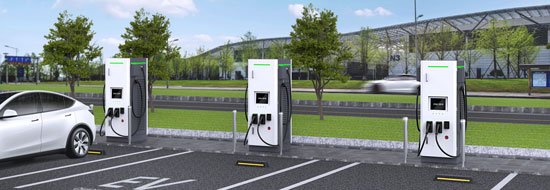Confession time: I was prepared to be underwhelmed. As a World Car of the Year juror, I’d been invited to have a go in a pre-production example of the Hyundai Ioniq 5 N, an about-to-be-launched performance version of the Korean powerhouse’s award-winning Ioniq 5. But I couldn’t help wondering. Did the regular old Ioniq 5, one of my favorite EVs, really need improving?
This SUV was a notably fine steer in standard form, with predictable, planted handling and sporty steering allied to respectable accelerative properties (especially in twin-motor four-wheel-drive spec)and ride quality that belied its near 4,700-lb curb weight. A tasteful, minimalist interior made of unusually high-quality materials impressed, while on the outside, its simple yet head-turning style somehow broke the mold of enforced tedium that defines every crossover-filled parking lot. And, lest we forget, its 350-kW DC fast-charging capability—the rarefied stuff of much more expensive machines—made it a star.
Remember how they used to say it never rains in southern California? Take my word for it, it rains in southern California, sometimes quite hard, such as when I met the 5 N. Weather like this tends to dampen the road-tester’s spirits. And I’d already arrived extra skeptical of two of the 5N’s signature upgrades. It purported to bring a pair of future technologies I thought I hated—simulated gearshifting and ersatz “engine” sound—to EV life. What could be sillier? What could be less authentic?
The quest for authenticity is, of course, the name of the game in our mad, modern world of never-ending branding opportunities. Founded or unfounded, weak or nonsensical, any facsimile of authenticity will do. In the world of selling and appreciating automobiles, we have this marketers’ holy grail to credit for the preternaturally long lives of the Volkswagen Beetle, Fiat 500, Porsche 911, plus the Jeep Wrangler, Mercedes G-Wagen, Land Rover Defender, Ford Mustang, Chevrolet Camaro, et al. All of these beloved machines remained on the market with sell-by dates long passed, their continued existence proving that however elusive and hard to acquire that comforting sense of authenticity can be, it’s a prize worth hanging on to.

Then along came the electric car. Where everything was new and different, including a fundamental lack of the sort of authenticity automobile fans are familiar with, the kind that comes only with time. EVs haven’t had time to weave themselves into our collective psyche, except maybe the Model S. Most haven’t been around very long at all. Looking more closely, if we consider the “authentic” ICE vehicles described above, they trace their roots only part of the way back to the beginning of the gasoline-powered automobile age. Perhaps that’s why we’re not seeing any latter-day tributes to the Model T or other exemplars of the early automotive age. Recognizing that EV tech remains relatively immature, despite the rapid advancement, maybe it’s not even fair to expect authenticity from cars being launched during the dawn of the era.
Still, what could be less authentic than fake sound and imaginary gears?
Well, folks, I’m here to tell you, an hour in the 5 N and I’d undergone a complete 180 on the subject. It was, quite simply, the liveliest, most fun new car I’d driven all year. Looking back on a lifetime of driving new cars, the only thing I could compare my reaction to was the feeling I got the first time I drove a Lancia Delta Integrale, that compact icon of mentalist all-wheel-drive performance. So fast, so agile, so fizzy, so entertaining to toggle between the gears. Then it struck me: The dual-motor, all-wheel-drive 5 N is an emission-free Integrale for our times. Minus, too, the delicate construction, crappy plastics, and presumptive unreliability.

So well have Hyundai’s engineers completed this esoteric and seemingly impossible task—turning an EV into a near-perfect stand-in for a living and breathing ICE rally machine—that their creation lulls even discerning drivers into thinking they’re downshifting and experiencing the real live sounds of a massively hotted-up four-cylinder engine. How do they do it? I’ll never know; I was a history major. But against all odds and prejudices, I endorse it thoroughly.
It’s not just the fake stuff. Real effort has been put into making the 5 N truly capable of taming all its power with even better handling, rendering it, in Hyundai-speak, a “Corner Rascal.” Numerous reinforcements of the body-in-white, motor and battery mounts, as well as strengthened drive axles and upgraded front and rear subframes all attest to the seriousness of the enterprise, as do 11 optional levels of torque distribution, quicker steering, a drift optimization function, and a programmable dash display.
Trying to reconcile these warm new feelings toward the 5 N with my cold old ones, I reflected on some truths about authenticity and the task at hand that bear mention. Few can doubt the need for safety’s sake of an onboard noise-making facility to telegraph the approach of an otherwise near-silent electric car. Some will happily opt, as they do today, for generic whirring or the sound of tinkling wind chimes. Though I like to think one day we may widen our aural aperture with cars that alert other road users to one’s imminent arrival with any of a billion sounds.
The eye-opening reverberations, for instance, of a semi-truck, running late and full up, following the sudden failure of its hydraulic stoppers, Jake brake belching, air horn deafening all within six city blocks. That will surely get most peoples’ attention. But no need to stop there. How about some choice numbers from the Ramones, instead? Or the guitar stylings of Yngwie Malmsteen? Tucker Carlson in high dudgeon might thrill some road users, while for others a blast of Jesse Jackson in 10/10ths sermonizing mode will telegraph the good word—I’m coming through!—loud and clear. You name it, it’s all technically possible. One might even toggle between them as the mood suits. Some might even ask, what exactly is wrong with the captivating sound of an internal combustion engine doing its thing, minus the unwholesome emissions? Because it’s fake? Please.

We must tread lightly when attempting to apply standards of automotive purity and authenticity to electric cars. Consider all the phony things we’ve seen through the world’s years of ICE automobiledom. Fake air scoops and brake ducts, useless driving lights. Bogus wire wheel covers. Fake wood dashboards, consoles, and interior door panels, with wood-aping vinyl appliques on the outside of family wagons. Imitation leather: as old as Father Time himself. Decorative carbon fiber that serves no useful purpose, least of all decoration, or the even more repellent fake carbon fiber. Non-functional side pipes, landau bars and do-it-yourself badging that turns a lowly 318 BMW into an M3. The list of frauds major and minor foisted upon the motoring consumer never ends.
So, join me, friends, and embrace the new automotive fakery, guilt-free. Put away the VR headset; the 5N is the most exciting, realistic, and compelling video game you’ve ever played. “Genuine” fun can’t get much better than the “fake” fun of this genius technological impostor. With its super-responsive make-believe paddle shifters and prodigious actual thrust and road-holding chops, its simulation of joy is indiscernible from the real thing.
One day, when you’re sitting in the back of your self-driving car, you may even remember it as authentic.
Jamie Kitman is a journalist, lawyer, and music manager based out of New York. He’s written for countless publications over his decades-long career, including The New York Times, Vanity Fair, Road & Track, and Automobile Magazine. His work has earned him a National Magazine Award for commentary and an Investigative Reporters & Editors award.
[ad_2]
Source link




